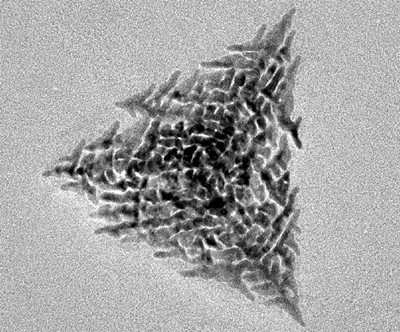The research group of Prof. Zeng Jie has made great breakthrough in the controlled synthesis of Pt-Cu bimetallic hierarchical structures and the mechanism investigation of their growth process. By carefully adjusting the kinetics of the nucleation and growth process, researchers synthesized Pt-Cu hierarchical trigonal bipyramid nanoframes (HTBNFs) in different sizes. This work has been published on (Angew. Chem. Int. Ed. 2014, 54, 108-113) with the title “Size-Controlled Synthesis of Platinum-Copper Hierarchical Trigonal Bipyramid Nanoframes”.

TEM image of Pt-Cu hierarchical nanocrystals
By combining Pt and Cu, forming an alloy will not only reduce the consumption of Pt, but also enhance the overall performance due to possible synergetic effects. Besides the composition, it is well-established that the catalytic properties of metal nanocrystals are also strongly correlated with their structure. The nanoframes with completely open and ultrathin structure have both high surface-to-volume ratios and large surface areas. In addition, it can increase molecular accessibility and accelerate mass diffusion during the reaction to some extent. As a special case of frame structure, the hierarchical nanoframes exhibit most of the advantages of frame structures. Besides, differently from the typical nanoframes, there are interlinked branches as bridges to connect each frame unit in the hierarchical frames. For a redox reaction, the interlinked branches of hierarchical nanoframes will develop a good ‘electrical’ connection between the site of oxidation and that of reduction. It will be helpful to electron transfer in the reaction and lead to a better catalytic performance. Researchers from Zeng Group successfully synthesized Pt-Cu HTBNFs in the size range of 110~250 nm through the kinetics manipulation. Besides, by changing the Pt/Cu feeding ratio, Pt-Cu HTBNFs with different ratios were obtained and the growth mechanism has been investigated systematically. Due to their unique structure and the synergistic effects between Pt and Cu, the as-prepared Pt-Cu HTBNFs give outstanding perfromance in the electrocatalytic oxidation of formic acid. This work will provide important instruction to the following syntheses and mechanism studies of metallic hierarchical structures.
This work was supported by 973 Program, NSFC, Recruitment Program of Global Experts, CAS Hundred Talent Program, and Fundamental Research Funds for the Central Universities.
(CHEN Sheng, HFNL )